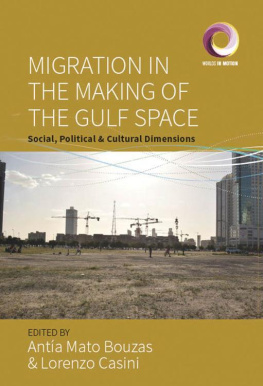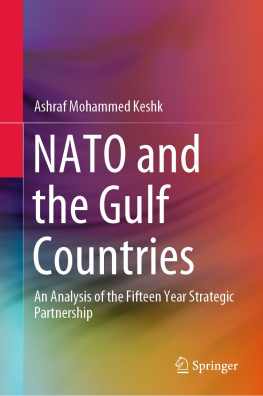MIGRATION IN THE MAKING OF THE GULF SPACE

| Edited by Noel B. Salazar, University of Leuven,
in collaboration with ANTHROMOB, the EASA
Anthropology and Mobility Network. |
This transdisciplinary series features empirically grounded studies from around the world that disentangle how people, objects, and ideas move across the planet. With a special focus on advancing theory as well as methodology, the series considers movement as both an object and a method of study.
Recent volumes:
Volume 11
MIGRATION IN THE MAKING OF THE GULF STATE
Social, Political, and Cultual Dimensions
Edited by Anta Mato Bouzas and Lorenzo Casini
Volume 10
WE ARE ALL AFRICANS HERE
Critical Engagements
Kristn Loftsdttir
Volume 9
LIMINAL MOVES
Traveling Along Places, Meanings, and Times
Flavia Cangi
Volume 8
PACING MOBILITIES
Timing, Intensity, Tempo and Duration of Human Movements
Edited by Vered Amit and Noel B. Salazar
Volume 7
FINDING WAYS THROUGH EUROSPACE
West African Movers Re-viewing Europe from the Inside
Joris Schapendonk
Volume 6
BOURDIEU AND SOCIAL SPACE
Mobilities, Trajectories, Emplacements
Deborah Reed-Danahay
Volume 5
HEALTHCARE IN MOTION
Immobilities in Health Service Delivery and Access
Edited by Cecilia Vindrola-Padros, Ginger A. Johnson, and Anne E. Pfister
Volume 4
MOMENTOUS MOBILITIES
Anthropological Musings on the Meanings of Travel
Noel B. Salazar
Volume 3
INTIMATE MOBILITIES
Sexual Economies, Marriage and Migration in a Disparate World
Edited by Christian Groes and Nadine T. Fernandez
Volume 2
METHODOLOGIES OF MOBILITY
Ethnography and Experiment
Edited by Alice Elliot, Roger Norum, and Noel B. Salazar
For a full volume listing, please see the series page on our website: https://www.berghahnbooks.com/series/worlds-in-motion
Migration in the Making of the Gulf Space
Social, Political, and Cultural Dimensions
Edited by
Anta Mato Bouzas and Lorenzo Casini

First published in 2022 by
Berghahn Books
www.berghahnbooks.com
2022 Anta Mato Bouzas and Lorenzo Casini
All rights reserved. Except for the quotation of short passages for the purposes of criticism and review, no part of this book may be reproduced in any form or by any means, electronic or mechanical, including photocopying, recording, or any information storage and retrieval system now known or to be invented, without written permission of the publisher.
Library of Congress Cataloging-in-Publication Data
A C.I.P. cataloging record is available from the Library of Congress
Library of Congress Cataloging in Publication Control Number: 2021056850
British Library Cataloguing in Publication Data
A catalogue record for this book is available from the British Library
ISBN 978-1-80073-350-3 hardback
ISBN 978-1-80073-351-0 ebook
Contents
Anta Mato Bouzas
Elizabeth Derderian
Nadeen Dakkak
Rana AlMutawa
Jaafar Alloul
Mohamed Shafeeq Karinkurayil
Lorenzo Casini and Deepak Unnikrishnan
Figures
Acknowledgments
This book is the outcome of an intense scholarly exchange that began at Leibniz-Zentrum Moderner Orient (ZMO), Berlin, in December 2019 as part of a project conducted by Anta Mato Bouzas and funded by the Deutsche Forschungsgemeinschaft (DFG). We would like to express our gratitude to the DFG and the ZMO that gave us the opportunity to start envisioning this work. At ZMO we would like to thank in particular Ulrike Freitag, Heike Liebau, Claudia Ghrawi, Sarah Jurkiewicz, Dietrich Reetz, Reyazul Haque, and Diana Gluck.
We would also like to express our gratitude to the Centre Franais de Recherche de la Pninsule Arabique (CEFREPAformerly known as Centre Franais dArchologie et Sciences Sociales CEFAS) in Kuwait and very specially to its director Abbs Zouache. CEFREPA was our host institution in Kuwait, and it is an excellent example of a European institution promoting research and academic exchange in the Gulf. We have no words to express the sense of hospitality provided by Abbs Zouache and his approach to promote the work of European as well as Kuwaiti academics, both established and young scholars. We are indebted to Dima Assad for facilitating our work but also for discussing with us the plurality of Gulf spaces. She is a great thinker and has become a good friend.
Finally, we cannot forget Tom Bonnington and Anthony Mason, editors at Berghahn Books, for their trust in us and for supporting this publication throughout this difficult period. We also express our deep gratitude to London Metropolitan University for providing a grant to edit this volume.
Introduction
Anta Mato Bouzas
Migration is a constituent feature of Gulf societies. It is framed in temporary terms, as if migrants remained for the period of their contracts and then left, presumably without a trace. Yet, migration has been a constant phenomenon for many decades, which in some cases has involved various generations of the same family and from the same communities. This volume examines the social reality of the permanent transient resident who is an active part of the process of placemaking and of the transmission of knowledge in the region. The contributions, which are from various disciplinary fields, draw on two main assumptions: first, that migration is regarded as integral to Gulf societies; and second, that the Gulf continues to exert an influence on other regions by way of migration diplomacy and on the construction of transnational spaces that involve citizens and noncitizens living in the Gulf. The chapters underscore how nonnationals of different categories try to appropriate this space as their own in what amounts to claims of membership. The volume also includes the often-underrepresented perspective of those who belong to the nationthat is, the ways in which citizens, in this case women from privileged classes, distinguish between Gulf and non-Gulf spaces in their condition as a minority group. Most of the contributions focus on the United Arab Emirates (UAE), yet the issues addressed in the chapters are representative of the rest of the Arab states in the Gulf. By being and living in the Gulf, migrants engage in a dialogical relationship with these ever-present others. However, this presence also affects the ways citizens and government actors negotiate their own Gulf spaces.
The aim of this book is to analyze how, by constructing new spaces, migration is shaping the Gulf Arab states. The volume emphasizes in particular the interactions of political, economic, social, and cultural fields. In this volume the notion of Gulf space bears a transnational dimension; what happens in the Gulf impacts the regions that send migrants there. Chapter 6 illustrates this in relation to the impact of Gulf migration on sartorial practices in the Indian state of Kerala. Therefore, the focus of this volume is not only on the Gulf states, but also on the regions that send migrants there. This approach reveals an enlarged Gulf space whose influence in other regions is enduring. Other contributions, such as those written by authors brought up in the Arab Peninsula, underscore the tensions that exist between the lived space of constant segregation and the representational space of the Gulf as a cosmopolitan place. How does this enlargement in terms of the Gulfs influence in other regions relate to its shrinkage, given that the Gulf is the result of what remains after constituting a wide range of outsiders?
Next page










